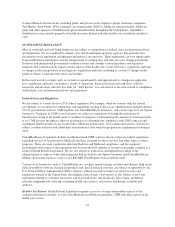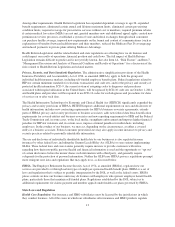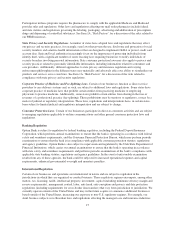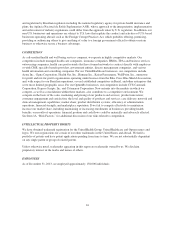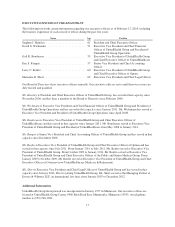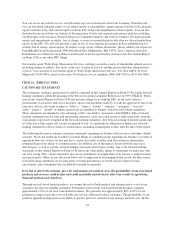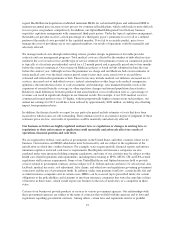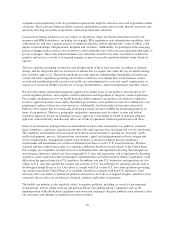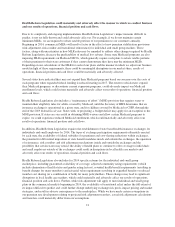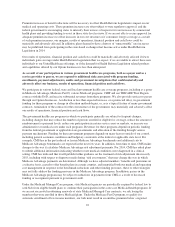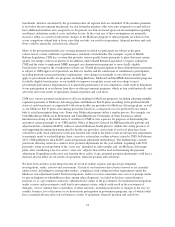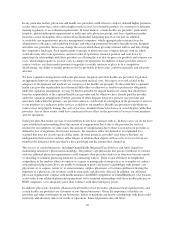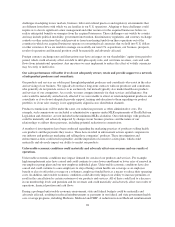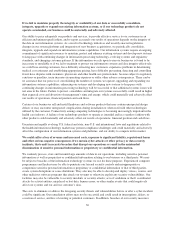United Healthcare 2013 Annual Report Download - page 23
Download and view the complete annual report
Please find page 23 of the 2013 United Healthcare annual report below. You can navigate through the pages in the report by either clicking on the pages listed below, or by using the keyword search tool below to find specific information within the annual report.Health Reform Legislation could materially and adversely affect the manner in which we conduct business
and our results of operations, financial position and cash flows.
Due to its complexity and ongoing implementation, Health Reform Legislation’s impact remains difficult to
predict, is not yet fully known and could adversely affect us. For example, if we do not maintain certain
minimum MLRs, we are required to rebate ratable portions of our premiums to our customers annually.
Beginning in 2014, commercial MLRs will need to factor in the effect of new premium stabilization provisions
(risk adjustment, risk corridor and transitional reinsurance) for individual and small group markets. These
factors, along with uncertainties in how MLR rules may be amended to address other changes required by Health
Reform Legislation, decrease the predictability of medical loss rebates. Some state Medicaid programs are also
imposing MLR requirements on Medicaid MCOs, which generally require such plans to rebate ratable portions
of their premiums to their state customers if they cannot demonstrate they have met the minimum MLRs.
Depending on our calculations of the MLR for each of our plans and the manner in which we adjust our business
model in light of these requirements, there could be meaningful disruptions in our market share, results of
operations, financial position and cash flows could be materially and adversely affected.
Several states have indicated they may not expand their Medicaid programs based on concerns over the costs of
such programs when expanded federal funding is reduced starting in 2017. The extent to which states expand
their Medicaid programs, or discontinue current expansion programs, could adversely impact our Medicaid
enrollment levels, which could in turn materially and adversely affect our results of operations, financial position
and cash flows.
Health Reform Legislation also includes a “maintenance of effort” (MOE) provision that requires states to
maintain their eligibility rules for adults covered by Medicaid, until the Secretary of HHS determines that an
insurance exchange is operational in a given state, and for children covered by Medicaid or CHIP, through the
end of the 2019 federal fiscal year. States with, or projecting, a budget deficit may apply for an exception to the
MOE provision. If states are successful in obtaining MOE waivers and allow certain Medicaid programs to
expire, we could experience reduced Medicaid enrollment, which could materially and adversely affect our
results of operations, financial position and cash flows.
In addition, Health Reform Legislation requires the establishment of state based health insurance exchanges for
individuals and small employers by 2014. The types of exchange participation requirements ultimately enacted
by each state, the availability of federal subsidies for premiums and cost-sharing reductions within exchanges,
the potential for differential imposition of state benefit mandates inside and outside the exchanges, the operation
of reinsurance, risk corridors and risk adjustment mechanisms inside and outside the exchanges and the
possibility that certain states may restrict the ability of health plans to continue to offer coverage to individuals
and small employers outside of the exchanges could result in disruptions in local health care markets and
adversely affect our results of operations, financial position and cash flows.
Health Reform Legislation also includes for 2014 specific reforms for the individual and small group
marketplace, including guaranteed availability of coverage, adjusted community rating requirements (which
include elimination of health status and gender rating factors), essential health benefit requirements (resulting in
benefit changes for many members) and actuarial value requirements resulting in expanded benefits or reduced
member cost sharing (or a combination of both) for many policyholders. These changes may lead to significant
disruptions in local health care markets, which could materially and adversely affect our results of operations,
financial position and cash flows. Further, while risk adjustment will apply to most individual and small group
plans in the commercial markets beginning in 2014, the availability of transitional relief makes the full extent of
its impact difficult to predict and could further disrupt underlying exchange risk pools, impact pricing and market
strategies, and result in adverse consequences to the marketplace. While we have made certain assumptions in
our premium rate development relating to projected risk adjustment transfers, actual risk adjustment calculations
and transfers could materially differ from our assumptions.
21



